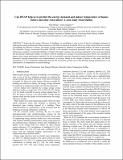| dc.contributor.author | Moran, Paul | |
| dc.contributor.author | Goggins, Jamie | |
| dc.date.accessioned | 2021-07-21T07:57:33Z | |
| dc.date.available | 2021-07-21T07:57:33Z | |
| dc.date.issued | 2020-08-27 | |
| dc.identifier.citation | Moran, Paul, & Goggins, Jamie. (2020). Can DEAP help us to predict the energy demand and indoor temperature of homes before and after renovation ? A case study from Dublin. Paper presented at the Civil Engineering Research in Ireland (CERI) 2020, Cork, Ireland, 27-28 August. | en_IE |
| dc.identifier.uri | http://hdl.handle.net/10379/16872 | |
| dc.description.abstract | Improving the energy efficiency of buildings via retrofitting is seen as one of the key mitigation measures to
reducing the energy demand and carbon emissions of the built environment in Ireland. However, while energy efficiency retrofits
for buildings are effective in theory, the energy savings estimated by statistical or engineering models can often be inaccurate.
The Domestic Energy Assessment Procedure (DEAP) is the standard assessment procedure used for assessing the energy
performance standard of residential buildings in Ireland. This paper examines the gas energy demand for space and water heating
and the internal temperature profiles in contrast to DEAP estimates for a group of social housing units which were retrofitted to
improve their energy performance standard. For the 16 households examined, theoretical energy demand was overestimated and
theoretical average temperatures were underestimated on average. Based on the sample of houses in this study, the DEAP
assumption of a 3°C temperature differential between the living area and the rest of the dwelling during heating hours is not
representative of temperatures in actual buildings. | en_IE |
| dc.description.sponsorship | The authors would like to acknowledge financial support from
Science Foundation Ireland (Grant No. 13/CDA/2200) and
from the European Union’s Horizon 2020 research and
innovation programme under grant agreement No 839134. The
authors would also like to thank Co-operative Housing Ireland
for facilitating access to homes for this study. | en_IE |
| dc.format | application/pdf | en_IE |
| dc.language.iso | en | en_IE |
| dc.publisher | Civil Engineering Research Association of Ireland (CERAI) and Cork Institute of Technology | en_IE |
| dc.relation.ispartof | Civil Engineering Research in Ireland (CERI) 2020 | en |
| dc.rights | Attribution-NonCommercial-NoDerivs 3.0 Ireland | |
| dc.rights.uri | https://creativecommons.org/licenses/by-nc-nd/3.0/ie/ | |
| dc.subject | Energy Performance Gap | en_IE |
| dc.subject | Energy Efficiency Retrofits | en_IE |
| dc.subject | Indoor Temperature Profiles | en_IE |
| dc.title | Can DEAP help us to predict the energy demand and indoor temperature of homes before and after renovation ? A case study from Dublin | en_IE |
| dc.type | Conference Paper | en_IE |
| dc.date.updated | 2021-07-20T23:55:07Z | |
| dc.local.publishedsource | https://sword.cit.ie/ceri/2020/14/3 | en_IE |
| dc.description.peer-reviewed | non-peer-reviewed | |
| dc.contributor.funder | Science Foundation Ireland | en_IE |
| dc.contributor.funder | Horizon 2020 | en_IE |
| dc.internal.rssid | 23388834 | |
| dc.local.contact | Paul Moran, Ryan Institute, School Of Engineering, & Informatics, Nui Galway. Email: paul.t.moran@nuigalway.ie | |
| dc.local.copyrightchecked | Yes | |
| dc.local.version | ACCEPTED | |
| dcterms.project | info:eu-repo/grantAgreement/SFI/SFI Career Development Award/13/CDA/2200/IE/Achieving nearly zero energy buildings - A life cycle assessment approach to retrofitting existing buildings (acronym: nZEB-RETROFIT)/ | en_IE |
| dcterms.project | info:eu-repo/grantAgreement/EC/H2020::CSA/839134/EU/TURNKEY solution for home RETROFITting/TURNKEY RETROFIT | en_IE |
| nui.item.downloads | 50 | |


